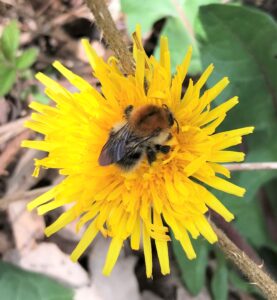Environment
- Barn owls
- Bats
- Bees (pollinators)
- Ecological surveying
- Hedgehogs
- Moths
- Otters
- Water voles
Bees (pollinators)

There are many invertebrate pollinators all of which are important, they help to provide us with the food we eat and the rich variety of habitats and plant life we can see, use and enjoy. Not many people realise that beetles, flies, moths, butterflies and wasps are pollinators as well as the more commonly recognized honeybees, bumblebees and solitary bees.
Classification of bees
There are around 250 species of Bee in the UK, made up of 24 species of bumblebee, around 225 species of solitary bee and a single species of honeybee. They form part of a large order of insects known as the Hymenoptera. In the UK there are 6 family groups which can be further classified in to genera and then individual species.
For example:
- Order – Hymenoptera
- Family – Apidae
- Genera – Bombus
- Species – Bombus Terrestris
The family groups of UK species
- Andrenidae – Solitary, subterranean nesting bees. Nests can be isolated or in an aggregation (meaning grouped together). Most species are polylectic (will feed on a variety of plants)
- Apidae – Includes bumblebees and honeybees
- Colletidae – Solitary short tongued bees, subterranean or aerial nesting. Some species are cleptoparasitic on other species in the same family
- Halictidae – Subterranean-nesting with short, pointed tongues
- Megachilidae – Long-tongued solitary bees. Pollen carrying hairs present on the abdomen rather than the hind legs (except for the cleptoparasitic species)
- Melittidae – Solitary bees with short, pointed tongues
Social or solitary?
Solitary bees
The majority of our bee species are solitary. They sometimes nest in large groups but each nest is the work of a single female, they have no queen or caste system.
The 2 types of solitary bees are:
- Mining bees – They excavate holes in the ground. Some species will use communal entrance holes but then branch off and create their own nest tunnels
- Cavity nesting bees – Masked, mason and leafcutter bees use existing cavities in wood, mortar or hollow plant stems, which they section off using mud or chewed leaves
Social bees
Only bumblebees and Honeybees are truly social bees. Each colony is comprised of a queen and female workers. The queen will lay the eggs which develop in to larvae which the workers care for. Older workers have the responsibility of foraging for nectar and pollen.
Gardening for pollinators
Your garden or allotment can provide valuable habitat for bees and other pollinators. When planting or sowing seeds, stick to native species and avoid highly cultivated plants, as they can be low in nectar and pollen. Nectar is a sugary substance that provides bees with energy, while pollen contains protein and fats to complete their dietary needs.
Try to provide a range of plants that will flower throughout the year from spring to autumn, the variety will also help to attract different species. There are some examples below.
March to April
Apple, bluebell, broom, bugle, cherry, erica carnea (heather), lungwort (pulmonaria), pear, plum, pussy willow, red dead-nettle, rosemary, white dead-nettle
May to June
Alliums, birds-foot trefoil, bugle, bush vetch, clustered bellflower, columbine, comfrey, everlasting pea, foxglove, geranium, honeysuckle, kidney vetch, lupin, monkshood, poppies, raspberries, red campion, sage, salvia, thyme, tufted vetch, meadow cranesbill, white clover, woundwort
July to September
Black horehound, borage, bramble, catmint, clustered bellflower, cornflower, delphinium, heathers, hollyhock, knapweed, lavender, lesser burdock, marjoram, mellilot, mint, purple loosestrife, red bartsia, red clover, rock-rose, sainfoin, scabious, sea holly, St. Johns wort, sunflower, teasel, thistles, viper’s bugloss
